RV Solar Charger Inverter
Introduction
In the realm of RV travel, harnessing the power of the sun has become a game-changer, and at the heart of this eco-friendly revolution lies the RV Solar Charger Inverter.
This vital component not only converts solar energy into electricity but also ensures a seamless integration with the RV’s power system.
Join us as we delve into the key aspects and advancements of this indispensable technology for the modern nomadic explorer.
Whether your interest lies in solar products, electric bikes, or other eco-friendly alternatives, our commitment to credibility ensures you have access to dependable insights, guiding your journey toward a more sustainable lifestyle.
Provo Green Products is your go-to destination for finding the right green products for your lifestyle.
Disclosure: We may earn a small commission if you click on one of our links. This will not affect the pricing of the product whatsoever.
RV Solar Charger Inverter
Definition and Purpose
- Definition: An RV Solar Charger Inverter is a specialized device designed to convert solar energy into usable electricity for recreational vehicles (RVs).
- Purpose: Its primary function is to harness the power of the sun, providing a sustainable and eco-friendly energy source for various appliances and systems within an RV.
Significance of Using Solar Power in RVs
- Environmental Impact: Emphasize the reduced carbon footprint and lower dependence on non-renewable energy sources.
- Cost Efficiency: Highlight the long-term financial benefits of solar power, including decreased reliance on traditional power outlets and campground fees.
Overview of Advancements in Solar Technology for RVs
- Efficiency Improvements: Discuss the evolution of solar panel technology, emphasizing increased efficiency and power generation.
- Compact Design: Explore how advancements have led to more lightweight and space-efficient solar panels, catering to the limited roof space on RVs.
- Integration with RV Systems: Touch upon how modern RV solar charger inverters seamlessly integrate with existing electrical systems, enhancing overall efficiency.
This introduction aims to provide readers with a foundational understanding of RV Solar Charger Inverters, setting the stage for a comprehensive exploration of their features, installation, maintenance, and future trends.
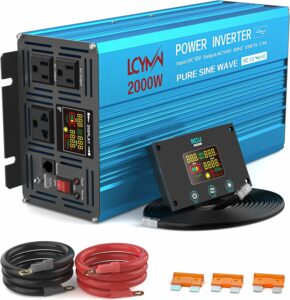
Key Features of Top-tier RV Solar Charger Inverters
Efficiency and Power Output
- High Conversion Rates: Top-tier inverters employ cutting-edge solar technology to achieve conversion rates exceeding traditional models. This results in more energy harvested from sunlight, optimizing power generation for RV use.
- MPPT Technology: Many advanced inverters utilize Maximum Power Point Tracking (MPPT) technology, dynamically adjusting the electrical operating point of the solar panels to maximize energy extraction under varying conditions.
Compatibility with RV Electrical Systems
- Seamless Integration: Beyond mere compatibility, these inverters are engineered for seamless integration with diverse RV electrical systems, minimizing installation complexities and ensuring efficient power distribution.
- Expandable Design: Recognizing the evolving needs of RV owners, top-tier inverters often feature expandable designs, allowing users to scale up their solar setup by adding more panels without compromising performance.
Durability and Weather Resistance
- Robust Construction: The durability of these inverters is enhanced through robust construction materials and design, capable of withstanding vibrations, shocks, and other physical stresses encountered during RV travels.
- IP Ratings: Achieving high Ingress Protection (IP) ratings, these inverters are often waterproof and dustproof, safeguarding internal components from the elements and ensuring reliable performance in diverse weather conditions.
Intelligent Charging Controllers
- Dynamic Charging: Intelligent charging controllers continuously monitor environmental conditions and battery status, dynamically adjusting the charging process for optimal efficiency and battery health.
- User-Friendly Interfaces: Top-tier inverters often feature user-friendly interfaces, providing RV owners with real-time data on energy production, consumption, and battery status for informed decision-making.
Integration with Existing Inverter Systems
- Parallel Operation: Some inverters support parallel operation, enabling RV owners to connect multiple units for increased power output while maintaining synchronization within the existing inverter network.
- Communication Protocols: Integration capabilities extend to communication protocols, allowing these inverters to seamlessly interface with other smart devices and automation systems within the RV.
This detailed exploration underscores the sophistication and versatility of top-tier RV solar charger inverters, showcasing their capabilities in maximizing energy efficiency, adaptability, and overall performance.
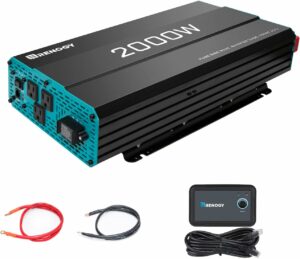
Installation and Setup of RV Solar Charger Inverters
Step-by-Step Guide on Installing Solar Panels on an RV
- Assessment of Roof Space:
- Solar Exposure Analysis: Conduct a detailed analysis of the RV’s travel patterns and parking locations to maximize solar exposure, optimizing energy harvesting potential.
- Aerodynamics Consideration: Discuss the importance of positioning solar panels for optimal aerodynamics, and minimizing wind resistance during travel.
- Mounting Procedures:
- Waterproof Sealing: Elaborate on the necessity of using high-quality sealants during the mounting process to ensure a waterproof seal, preventing leaks and potential damage to the RV interior.
- Tilt and Swivel Mounts: Introduce the benefits of tilt and swivel mounts, allowing users to adjust the angle of solar panels for maximum sunlight absorption throughout the day.
- Wiring Configuration:
- Series vs. Parallel Wiring: Explain the differences between series and parallel wiring configurations, guiding users on selecting the most suitable option based on their solar panel setup.
- Color Coding: Emphasize the importance of color-coded wiring for easy identification and troubleshooting, reducing the risk of errors during installation.
Connecting the Solar Panels to the Inverter
- Selection of Wiring Components:
- High-Quality Connectors: Stress the significance of using high-quality connectors to minimize power loss and ensure a reliable connection between solar panels and the RV solar charger inverter.
- Cable Management: Provide tips on proper cable management, securing cables to prevent damage, and ensuring a neat and organized installation.
- Inverter Placement:
- Ventilation Requirements: Discuss the ventilation needs of the inverter and recommend a strategic placement to facilitate proper cooling, preventing overheating during operation.
- Inverter Enclosures: Introduce the option of using weatherproof enclosures for inverters when installed in external locations, enhancing protection against the elements.
- Wiring Best Practices:
- Wire Gauge Considerations: Explain the importance of selecting the appropriate wire gauge based on the distance between solar panels and the inverter, optimizing electrical conductivity.
- Chafing Protection: Highlight the use of conduit or protective sleeves to safeguard wiring from chafing against sharp edges or abrasive surfaces within the RV.
Ensuring Proper Grounding and Safety Measures
- Grounding Procedures:
- Grounding Rod Installation: Guide users through the installation of grounding rods, ensuring a low-resistance path for electrical currents to enhance system safety.
- Periodic Grounding Checks: Emphasize the need for periodic checks to maintain effective grounding, especially after extended periods of travel or changes in environmental conditions.
- Surge Protection:
- Surge Protector Installation: Provide detailed instructions on installing surge protectors, safeguarding the entire solar power system from voltage spikes and transient surges.
- Surge Protector Maintenance: Recommend regular maintenance checks on surge protectors to verify their continued effectiveness in protecting the RV’s electrical infrastructure.
- Safety Precautions:
- Electrical Safety Guidelines: Offer a comprehensive list of electrical safety guidelines, covering topics such as wearing appropriate PPE, disconnecting power sources during installation, and avoiding common electrical hazards.
- Emergency Protocols: Provide clear emergency protocols for users to follow in the event of electrical issues, emphasizing the importance of swift action to ensure personal safety and prevent damage to the RV.
Configuring Charging Parameters for Optimal Performance
- Inverter Settings:
- Charging Modes Overview: Explain the various charging modes offered by the inverter, such as bulk, absorption, and float, and guide users in selecting the most suitable mode based on battery type and usage patterns.
- Customization Features: Explore any additional customization features the inverter may offer, allowing users to tailor the charging parameters to their specific needs.
- Battery Configuration:
- Battery Bank Setup: Detail the process of setting up a battery bank, including considerations for connecting batteries in series or parallel to achieve the desired voltage and capacity.
- Battery Maintenance Tips: Provide practical tips for maintaining RV batteries, extending their lifespan, and ensuring consistent performance over time.
- Monitoring Systems:
- Energy Monitoring Devices: Introduce the use of energy monitoring devices that allow RV owners to track energy production, monitor battery levels, and identify potential issues in real-time.
- Remote Monitoring Apps: Discuss the availability of remote monitoring apps, enabling users to access system data and receive alerts via smartphones or other devices, enhancing convenience and control.
This detailed expansion offers a comprehensive guide for RV owners undertaking the installation and setup of their solar power systems.
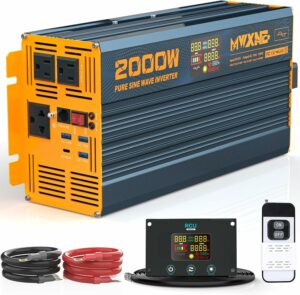
Maintenance and Troubleshooting Tips
Regular Checks for Solar Panel Cleanliness and Functionality
- Routine Inspection Schedule:
- Establish a regular inspection schedule, recommending monthly checks for dust, debris, and any signs of physical damage on solar panels.
- Emphasize the importance of more thorough inspections after long periods of inactivity or exposure to harsh weather conditions.
- Cleaning Procedures:
- Provide step-by-step cleaning procedures, advising the use of a soft brush or sponge with a mild detergent solution for effective removal of dirt without causing damage.
- Caution against abrasive materials or harsh chemicals that could scratch or degrade the solar panel surface.
- Visual Inspection:
- Guide users on a visual inspection of each solar panel for discoloration, cracks, or hotspots, as these could indicate underlying issues affecting performance.
Monitoring Battery Health and Voltage Levels
- Regular Battery Checks:
- Recommend routine checks of individual batteries in the bank, assessing for signs of corrosion, and electrolyte levels in lead-acid batteries, and ensuring proper connections.
- Encourage the use of a battery hydrometer or multimeter for accurate voltage readings.
- Equalizing Charge Cycles:
- Explain the concept of equalizing charge cycles for lead-acid batteries, emphasizing its importance in preventing stratification and ensuring uniform charging across all cells.
- Capacity Testing:
- Advise periodic capacity testing to assess the actual energy storage capacity of the batteries, identifying any degradation over time.
Identifying and Resolving Common Issues with Inverters
- Overheating Prevention:
- Educate users on maintaining proper ventilation around the inverter to prevent overheating, ensuring that cooling fans or vents are unobstructed.
- Discuss the potential impact of high ambient temperatures on inverter efficiency.
- Error Code Interpretation:
- Provide a guide for interpreting common error codes displayed by inverters, assisting users in identifying the root cause of issues.
- Suggest specific actions or troubleshooting steps corresponding to different error codes.
- Firmware Updates:
- Emphasize the importance of keeping the inverter firmware up to date, explaining how manufacturers often release updates to address performance issues or introduce new features.
Tips for Extending the Lifespan of the Entire Solar Power System
- Battery Maintenance Practices:
- Elaborate on best practices for maintaining battery health, including avoiding deep discharges, ensuring proper ventilation, and addressing sulfation issues promptly.
- Inverter Protection Measures:
- Recommend the use of surge protectors or lightning arrestors to safeguard the inverter and other electrical components from electrical surges.
- Advise users to disconnect the inverter during long periods of inactivity to prevent unnecessary power consumption.
- Weather-Related Precautions:
- Offer guidance on protective measures during extreme weather conditions, such as securing solar panels during storms, and disconnecting the system during extended periods of non-use.
Future Trends in RV Solar Charger Inverter Technology
- Emerging Technologies:
- Explore upcoming technologies, such as advanced materials for more efficient solar panels, and improvements in energy storage solutions like lithium-ion batteries.
- Smart Features and IoT Connectivity:
- Discuss the integration of smart features, such as remote monitoring and control via mobile apps, and the potential for IoT connectivity to enhance system intelligence.
- Environmental Benefits and Sustainability:
- Highlight ongoing developments focused on making RV solar power systems even more environmentally friendly, with an emphasis on recyclability and reduced environmental impact.
This detailed guide on maintenance and troubleshooting aims to empower RV owners with the knowledge needed to ensure the longevity and optimal performance of their solar power systems.
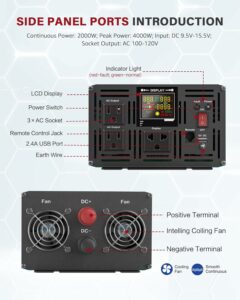
Future Trends in RV Solar Charger Inverter Technology
Emerging Technologies
- Advanced Photovoltaic Materials:
- Discuss ongoing research and development in materials science, exploring advanced photovoltaic materials that promise higher efficiency, increased durability, and reduced manufacturing costs.
- Highlight potential breakthroughs in thin-film solar technology and their application in RV solar panels.
- Quantum Dot Solar Cells:
- Introduce the concept of quantum dot solar cells, an emerging technology that has the potential to enhance the efficiency of solar panels by capturing a broader spectrum of sunlight.
- Discuss the implications of quantum dot solar cells for RVs, including increased power generation in varying light conditions.
Integration of Smart Features and IoT Connectivity
- Remote Monitoring and Control:
- Explore the integration of advanced monitoring systems that allow RV owners to remotely track the performance of their solar power systems via smartphone apps or web interfaces.
- Discuss real-time data on energy production, battery status, and system health, providing users with greater control and insight.
- Predictive Maintenance:
- Highlight the potential for predictive maintenance features, where the inverter can analyze data trends to predict potential issues before they occur.
- Discuss how this predictive capability can reduce downtime and enhance the overall reliability of RV solar power systems.
- IoT Connectivity:
- Discuss the incorporation of Internet of Things (IoT) connectivity, enabling seamless communication between the solar charger inverter, other smart devices within the RV, and cloud-based platforms.
- Explore how IoT connectivity can contribute to energy optimization, remote diagnostics, and automatic software updates.
Advancements in Energy Storage Solutions
- Next-Generation Batteries:
- Explore advancements in battery technology, focusing on next-generation batteries with higher energy density, faster charging capabilities, and longer lifespans.
- Discuss the potential adoption of lithium-sulfur batteries or solid-state batteries for RV solar power systems.
- Hybrid Energy Storage Systems:
- Introduce the concept of hybrid energy storage systems that combine traditional batteries with supercapacitors or other innovative storage technologies.
- Discuss the benefits of improved energy density, faster charging, and increased reliability in hybrid systems.
Environmental Benefits and Sustainability
- Recyclable Materials:
- Discuss the shift toward using recyclable materials in the manufacturing of solar panels and inverters, aligning with the growing emphasis on sustainability.
- Explore the potential for eco-friendly disposal methods for end-of-life components.
- Circular Economy Practices:
- Highlight the adoption of circular economy practices, where manufacturers design products with longevity in mind, facilitate easy upgrades or repairs, and promote recycling at the end of the product lifecycle.
- Discuss how these practices contribute to reducing electronic waste and environmental impact.
Integration with RV Systems
- Seamless Integration with RV Electronics:
- Discuss the trend of RV solar charger inverters being designed to seamlessly integrate with other electronic systems within the RV, such as energy management systems, entertainment systems, and climate control.
- Explore how enhanced integration contributes to a more unified and efficient RV experience.
- Automation and AI Integration:
- Explore the potential integration of automation and artificial intelligence (AI) algorithms within RV solar power systems.
- Discuss how AI can optimize energy usage, predict energy needs based on user behavior, and enhance overall system efficiency.
This exploration of future trends in RV Solar Charger Inverter Technology provides a glimpse into the exciting developments that may shape the landscape of RV solar power systems.
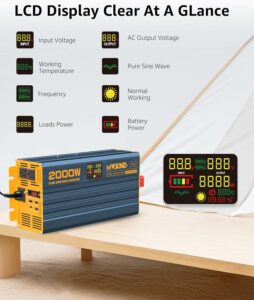
Conclusion
The world of RV solar power is on the brink of transformative advancements.
As we anticipate the integration of cutting-edge technologies like quantum dot solar cells, IoT connectivity, and advanced energy storage solutions, the future holds promise for more efficient, intelligent, and sustainable RV solar charger inverters.
Embracing these innovations ensures that RV enthusiasts will not only enjoy enhanced energy independence but also contribute to a greener and more eco-conscious travel experience.
The journey towards the next era of RV solar technology is both thrilling and environmentally impactful.
Stay in Touch!
I’am a dedicated entrepreneur with many years of experience and an integrity-driven individual who is highly motivated to succeed. Leveraging extensive expertise in manufacturing, construction, and various trades, we can provide a solid foundation for sustainable living. Our meticulous research process guarantees that our information about each product is precise and current, allowing you to make informed decisions. A deep understanding of business operations empowers me to consistently implement improvements that result in ongoing success. Visit site.
